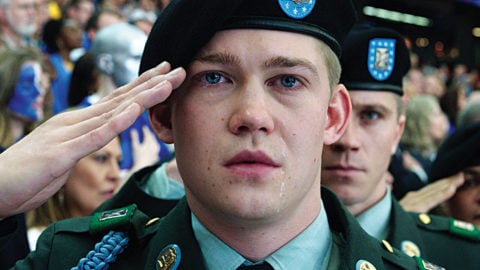Deep Focus: Billy Lynn’s Long Halftime Walk
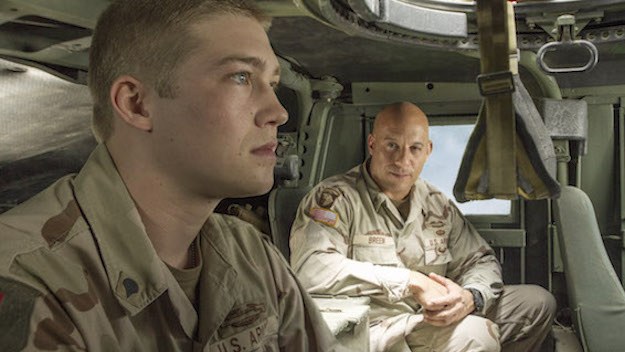
The title character of Ang Lee’s frontline/home-front Iraq War movie, Billy Lynn’s Long Halftime Walk, a U.S. Army specialist (played pallidly by British newcomer Joe Alwyn), gets lionized for springing to the defense of a wounded sergeant on a video replayed endlessly on cable news, then gets flown back to America for a two-week victory tour. The movie aims to dramatize how America’s marketing of sentimental patriotism can render undeniable heroism inauthentic, not just to citizens who don’t really want to think about the war but also to the hero himself.
Ben Fountain’s source book of the same name was misleadingly hailed as “the Catch-22 of the Iraq War.” Lynn is less like a Yossarian than he is like a down-home Candide. He’s an inchoate every-lad—19 and still a virgin. When the Army’s P.R. arm turns Billy and his squad-mates, “the Bravos,” into poster boys for post-9/11 valor, they become a moving part of Destiny’s Child’s 2004 Turkey Day halftime show at Texas Stadium. (It comes in the middle of one of the worst NFL games ever played, the Cowboys’ 21-7 loss to the Chicago Bears.) Billy may be a native of fictional Stovall, Texas, but he feels no kinship to the Dallas high-rollers, expensive gladiators, and entitled fans he encounters in the luxury boxes and high-priced seats of “America’s Team.” By the end of the film, he and his buddies engage in pitched combat not just with Iraqi insurgents but also with pissed-off rock-star roadies and stage managers.
Billy Lynn’s Long Halftime Walk has been trumpeted as a technological great leap forward. Lee shot the film at a rate of 120 frames per second (instead of 24), with 4K resolution and in 3D. It’s too bad Lee has applied what Tri-Star Pictures calls “New Cinema” to an “Old Cinema” screenplay: a heavy-handed spectacle that both exploits and condemns American excess. I saw the film without 3D or super-speedy projection—the way it will play in most theaters. In a conventional format, the film’s luminosity and exactness are still impressive. But they’re not expressive. How could they be? Billy Lynn’s Long Halftime Walk is essentially a one-character movie with just two fully dramatized sequences.
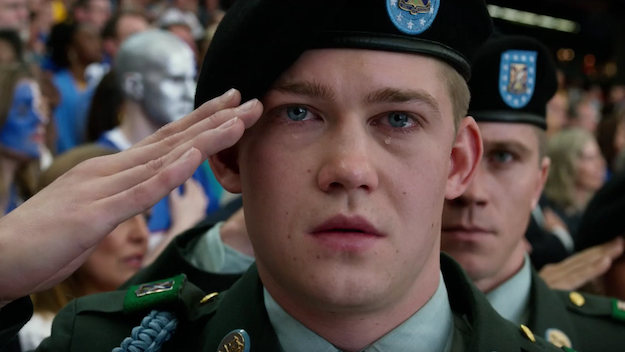
Fountain’s novel thrives on the way it stitches together a confused, heroic soldier’s wayward streams of consciousness with his comrades’ gifts of gab. It cries out for aural, not visual, virtuosity. To pull it off as a movie, Ang Lee would have had to create a latter-day soundtrack as layered, playful, and suggestive as Robert Altman’s M*A*S*H. Of course, to do that, he might have needed to cast a lead actor able to improvise in the American vernacular instead of a male Brit ingénue who makes you wonder, “What’s the masculine phrase equivalent of ‘an English rose?’ ’” Lee and screenwriter Jean-Christophe Castelli reduce Fountain’s best bits of dialogue to preachments or punch lines.
The movie takes place during a single day (Thanksgiving), but Billy’s ruminations and flashbacks create a kaleidoscopic narrative. Unfortunately, each past- or present-tense vignette is purposeful to a fault, whether it’s depicting flesh-and-blood combat in Iraq, psychological warfare in the hero’s dysfunctional home, or a brotherhood sending off a fallen mate with a rough-and-ready service at a military cemetery. Lee strives to achieve a free-association kind of looseness and to scale lunatic highs. But here he’s far too cautious a filmmaker. He wants to use his cutting-edge technology to make us to feel as if we’re dropping through a psychic trapdoor into Billy’s hyper-sensitized consciousness. Yet the movie is cripplingly steady even when it’s being hyperbolic. Every piece of show biz and NFL glitz or Iraq War grit is too contained.
When the book came out in 2012, Fountain told Teddy Wayne in the Huffington Post that his creative impulse came from watching the actual Cowboys half-time show on TV, on Nov 25, 2004:
The show was very much like the one I describe in the book, this surreal and patently insane — to me, anyway — mash-up of militarism, pop culture, American triumphalism and soft-core porn. At one point during the show the camera flashed on a group of soldiers who were marching along with everyone else down on the field, and they looked like actual combat soldiers. They were in desert camo, and looked lean and tan; my sense was that they’d been over there fighting in Iraq or Afghanistan. And I wondered what it would do to your head, to have been over there immersed in daily life-or-death situations, then you return to the U.S. and get plunked down in the middle of this very artificial situation. How, in other words, would you keep from going crazy?
Watching that halftime show seemed to crystallize a lot of things I’d been feeling and thinking up to that point. I was confused; I didn’t have a clue about why America is the way it is, this place where I was born and had spent my entire life. I didn’t understand my own country. In some ways, writing Billy Lynn was an attempt to make some kind of sense of the place, or at least to put a frame around my fundamental confusion.
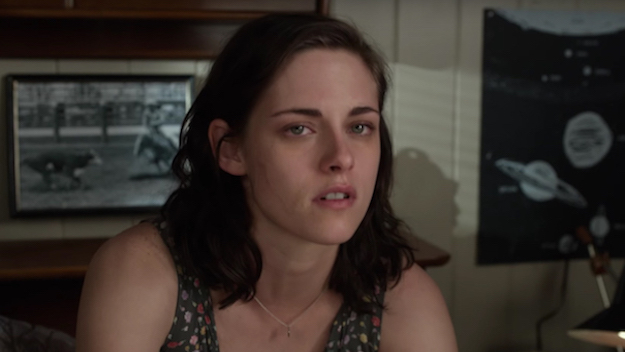
The central metaphor on the page and screen is the same: Texas Stadium during a turkey bowl as “the sheltering womb of all things American—football, Thanksgiving, television, about 800 kinds of police and security personnel, plus 300 million well-wishing fellow citizens.” Fountain filters his description of the extravaganza, which includes the United States Army Drill Team and the Prairie View A&M Marching Storm band, more successfully through the eyes of a super-observant, ultra-sensitive Billy, who will redeploy to Iraq in two days.
Lee does a decent job of putting the audience in Billy’s boots as he and his fellow Bravos parade down the field and react to the sensory overload of snare drums and majorettes and cheerleaders. But Lee rarely succeeds at opening up the issues within Billy’s head. In the book, Billy muses, “If there ever was a prime-time trigger for PTSD, you couldn’t do much better than this.” When he checks his own racing pulse and adrenaline, it’s as if he’s testing his own sanity: “Pupils dilated, pulse and blood pressure through the roof, limbs trembling with stress-reflex cortisol rush, but it’s cool, it’s good, their shit’s down tight, no Vietnam-vet crackups for Bravo squad!” Unfortunately, the way Lee and Castelli have pruned the story and its verbal onslaughts, mistakenly resisting and clarifying narration, the movie really does come off as a portrait of a soldier who’s in denial about having full-blown PTSD. So the ending comes as an abrupt about-face.
As the back story emerges both in scenes set at his Texas home and another on his base in his Iraq, we learn that Billy’s rebellious sister Kathryn (a generically intense Kristen Stewart), at odds with the rest of the family partly because she opposes the Iraq War, feels responsible for his enlistment. A couple of years before, her fiancé dumped her after she survived a scarring car accident; Billy took revenge by reducing the moral weakling’s Saab to a heap of metal, then using a tire iron to threaten the creep himself. Billy’s willingness to join the Army was his get-out-of-jail free card. During his P.R. visit stateside, Kathryn becomes convinced that Billy has been psychologically scarred. Between his tremulous responses to his sister’s repeated, texted pleas for him to leave the Army, and his own recurring flashbacks to the death of his sergeant and mentor, the instinctive and unconventional “Shroom” (Vin Diesel), the film seems to characterize Billy, deceptively, as a warrior about to fall apart. The filmmakers miss their mark, whether they mean to toy with our expectations or to draw the finest line between normality and madness.
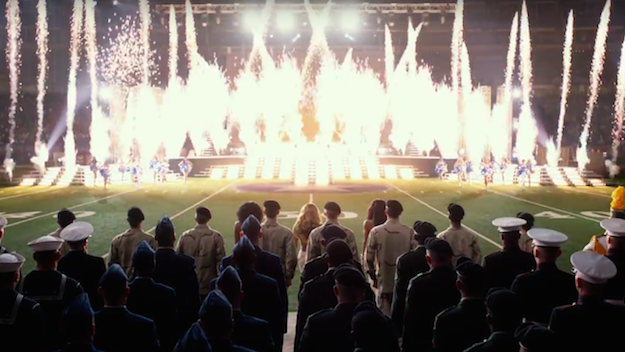
As far as physical re-creation goes, Lee pulls out all the stops on the half-time show, as drum lines and flag girls criss-cross the field and Destiny’s Child (solid impersonators for Beyoncé, Kelly, and Michelle) command the audience with their hip-swinging swagger. Lee captures some terrific shots of drum majors and dancers jolting Billy as they invade his marching space. But after he’s directed to stand in place on a stage, Billy tunes out of the pageant, which quickly faded from my memory. Afterward, I located the real event on YouTube and found it infinitely more fascinating and touching, even (or especially) without Billy’s fictional histrionics: the sight of soldiers stumbling into each other and the drill team accentuates the poignancy and absurdity of America’s desperate urge to honor its heroes in the gaudiest ways. In the movie, everything simply funnels into Billy’s most prolonged flashback to Iraq and his biggest tribute to his mentor, Sergeant “Shroom” (Diesel overdoes his macho-guru vibe). Shroom’s studies in Eastern wisdom include the lesson that if a soldier is meant to die, the bullet that kills him has already been shot. Shroom also teaches Billy, in what may be this movie’s ultimate message, that Americans are children who must go to other countries to grow up.
It’s difficult to know how to respond to Billy’s experience of first love—or at least a high-flown form of lust—with a Dallas Cowboys Cheerleader named Faison (Makenzie Leigh), who is a true believer in Billy’s valor and in Christianity. Lee has a gift for unexpected romantic assignations, and Leigh and Alwyn generate both a touching romantic aura and some erotic heat. But this coupling is too clipped and hazy. Her disbelief that he’d want to go AWOL and run away with her carries too much weight in his ultimate decision of whether to flee or fight.
The movie eventually comes into focus as a bleak, mirthless service comedy combined with a coming-of-age-story. Will Billy accept his newfound identity as a soldier no matter what he thinks of this particular war? The stronger questions come from a show-biz subplot about a producer/agent (Chris Tucker) who tries to put the Bravos’ story up for sale. Will Billy protect his saga from Hollywoodization, when he learns that Hilary Swank may want to play his role? Will he refuse to compromise on a partnership with the Cowboys’ fictional owner, Norm Oglesby, who peddles a cheapskate jingoism? (Steve Martin, as Norm, disappointingly mistakes a put-on for a performance.)
The Bravos learn that to get a major star, you need a major budget, but to get a major budget, you need a major star. That’s the only time this movie brings to mind a Catch-22. Lee’s visuals are eye-popping in Billy Lynn’s Long Half-time Walk. What the movie lacks is a clear vision.
Michael Sragow is a contributing editor to Film Comment and writes its Deep Focus column. He is a member of the National Society of Film Critics and the Los Angeles Film Critics Association. He also curates “The Moviegoer” at the Library of America website.



